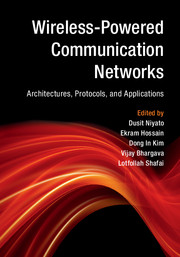Book contents
- Frontmatter
- Contents
- List of contributors
- Preface
- Part I Basics of Wireless Energy Harvesting and Transfer Technology
- Part II Architectures, Protocols, and Performance Analysis
- 4 Cooperative Networks with Wireless Energy Harvesting
- 5 Multiple Antennas and Beamforming for SWIPT Systems
- 6 Backscattering Wireless-Powered Communications
- 7 Dedicated Wireless Energy Harvesting in Cellular Networks: Performance Modeling and Analysis
- 8 Ambient Wireless Energy Harvesting in Small Cell Networks: Performance Modeling and Analysis
- Part III Applications of Wireless Energy Harvesting and Transfer
- Index
- References
4 - Cooperative Networks with Wireless Energy Harvesting
from Part II - Architectures, Protocols, and Performance Analysis
Published online by Cambridge University Press: 01 December 2016
- Frontmatter
- Contents
- List of contributors
- Preface
- Part I Basics of Wireless Energy Harvesting and Transfer Technology
- Part II Architectures, Protocols, and Performance Analysis
- 4 Cooperative Networks with Wireless Energy Harvesting
- 5 Multiple Antennas and Beamforming for SWIPT Systems
- 6 Backscattering Wireless-Powered Communications
- 7 Dedicated Wireless Energy Harvesting in Cellular Networks: Performance Modeling and Analysis
- 8 Ambient Wireless Energy Harvesting in Small Cell Networks: Performance Modeling and Analysis
- Part III Applications of Wireless Energy Harvesting and Transfer
- Index
- References
Summary
Introduction
Energy harvesting has emerged as one of the enabling technologies for Green Communication. As the name suggests, energy harvesting is a technique by which energy of ambient sources, for example, solar, wind, and thermal, is converted into electrical energy and used to power network equipment or mobile devices [1, 2]. This technology makes use of perpetual renewable energy sources, which reduces the consumption of high-cost constant energy sources. Lately, wireless power transfer has gained much attention in the field of energy harvesting since wireless signal is also an ambient source of energy in itself [3, 4]. Owing to the lower range of harvested energy, RF energy harvesting has potential for powering smaller network nodes.
Wireless energy harvesting technology has been studied in two different paradigms of wireless communication networks. The first is simultaneous wireless information and power transfer (SWIPT) in downlink [5–7]. The SWIPT technique is used to transmit wireless energy to user equipments (UEs) whilst carrying out downlink information transmission to them as shown in Figure 4.1. The technological requirements necessary to enable this simultaneous information and energy transmission at the receiver circuit will be discussed later in this chapter. The SWIPT technique increases the energy efficiency of the network since the energy cost decreases for UEs capable of harvesting energy from the received information signal [8]. In other words, energy spent at the information transmitter is partially reused at the receiver. The reuse of energy is partial mainly because of the path-loss and non-ideal energy harvesting efficiency.
On the other hand, when the UEs are carrying out uplink transmission, it is not possible to transmit energy to them using the SWIPT technique. Hence, another important paradigm of wireless energy harvesting networks is wireless-powered communication (WPC) in the uplink [9, 10]. In this technique, some fraction of the uplink transmission duration is dedicated to downlink energy transmission (DET) from the access point (AP) to the UEs. The energy harvested during this time is utilized by the UEs for uplink information transmission (UIT) to the AP in the remaining fraction of time as shown in Figure 4.2.
- Type
- Chapter
- Information
- Wireless-Powered Communication NetworksArchitectures, Protocols, and Applications, pp. 135 - 169Publisher: Cambridge University PressPrint publication year: 2016



